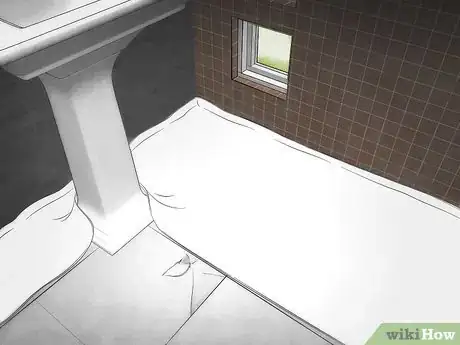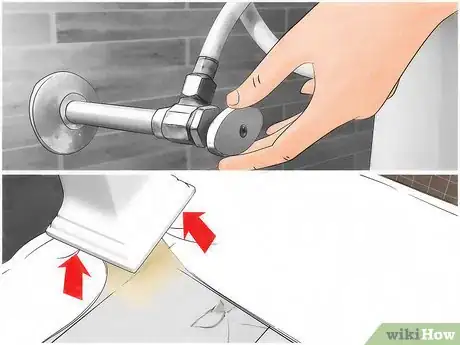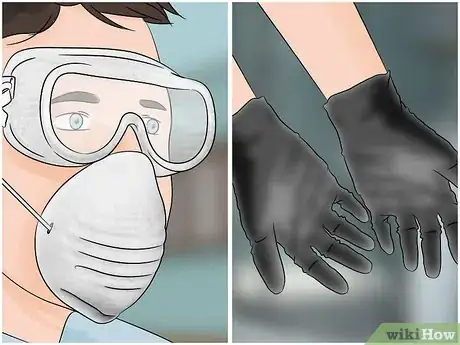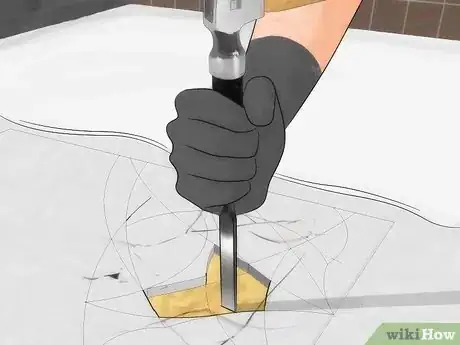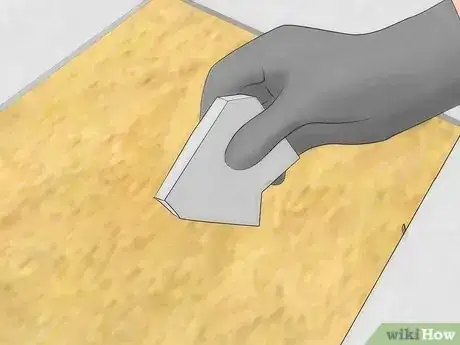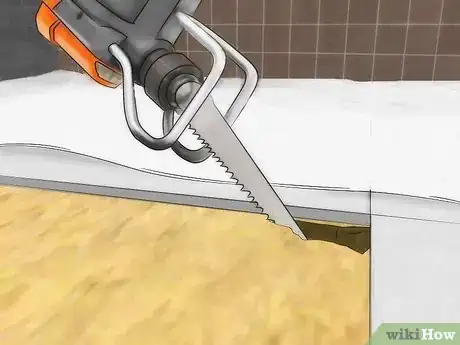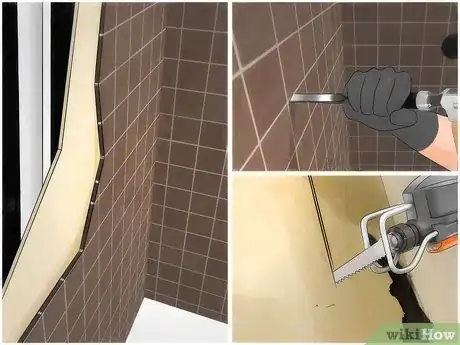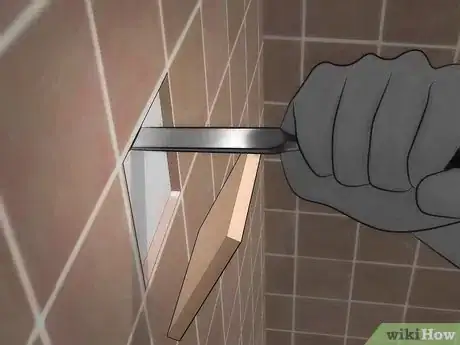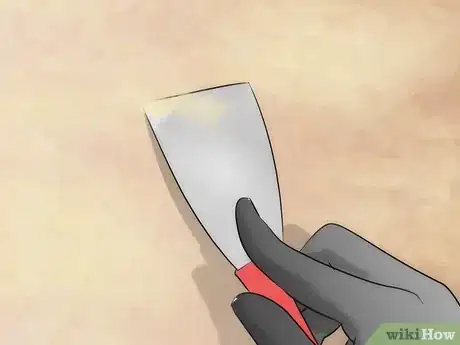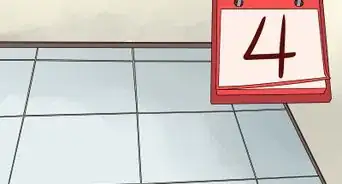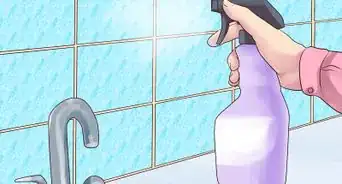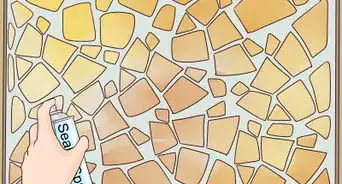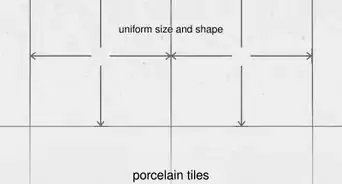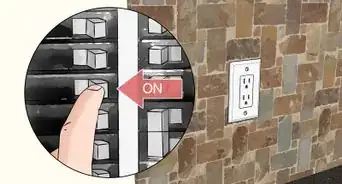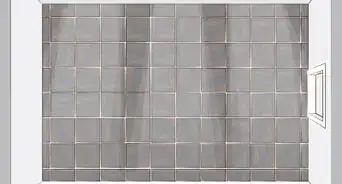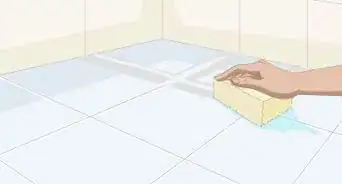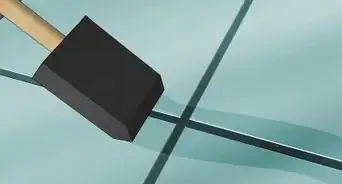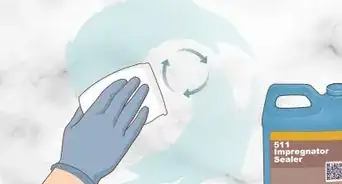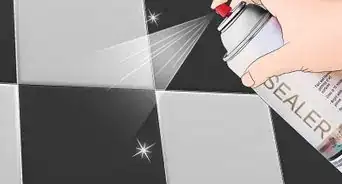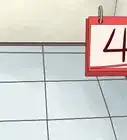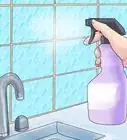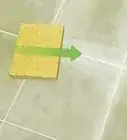This article was co-authored by Art Fricke. Art Fricke is a home renovation and repair specialist and the owner of Art Tile & Renovation based in Austin, Texas. With over 10 years of experience, he specializes in bathroom and kitchen renovations. Art focuses on a single contractor approach to customized renovation work, and performs projects such as installing custom tile showers, fixing tiled shower leaks, replacing cracked tiles, and installing floor and wall tile.
There are 9 references cited in this article, which can be found at the bottom of the page.
wikiHow marks an article as reader-approved once it receives enough positive feedback. In this case, 92% of readers who voted found the article helpful, earning it our reader-approved status.
This article has been viewed 301,714 times.
Removing ceramic tiles is a time consuming job, especially if you're trying to preserve them for reuse elsewhere. If your tiles are only chipping off in tiny pieces, you may need to spend more time scraping out grout, or switch to power tools instead of a hand chisel.
Steps
Removing Floor Tile
-
1Protect fixtures and usable floor with drop cloth. Remove all unnecessary objects from the room. Cover bathtubs, counters, mirrors, and other fixtures with a drop cloth to protect them from flying pieces of tile. Carefully cover any drains with painter’s tape. Lay down drop cloth over any part of the floor you plan to keep as well.
- For hygienic reasons, clean the bathroom thoroughly before you continue.
-
2Remove the toilet, if necessary. If the toilet (or a pedestal sink) is covering the tile, turn off the shutoff valve on the water supply line. Flush the toilet until the tank and bowl are both dry, finishing the job with a hand-operated pump, then a sponge. Detach the tank using a wrench. Set the tank and the toilet aside on old towels or other absorbent materials.
- Leave the tank and bowl attached, and remove both at once.
- You may need to rock the toilet back and forth to break the caulk, or cut away the caulk with a utility knife.
- Carefully remove the wax ring that creates a seal between the base of the toilet and the drainage pipe. You may wish to wear gloves during this process, since the wax ring is very sticky. Clean any remaining wax off the base of the toilet with a rag soaked in mineral spirits.
- You will need to replace the wax ring with a new one when you re-install the toilet.[1] Consider retrofitting your toilet with a wax ring that comes with an extension to accommodate higher flanges.
- After removing the toilet, plug the hole with a rag to block sewer gases.
Advertisement -
3Put on safety equipment. Wear heavy-duty gloves, wraparound safety goggles, and long sleeves to protect yourself from sharp tile pieces. Wear a dust mask to protect against dust from pulverized tile. You should also wear work pants, a hat, and work boots.
- Ceramic tiles and mortar commonly contained asbestos until the 1980s in the US, and the 1990s in some regions.[2] Test old tiles and mortar for asbestos and, if asbestos is found, hire a professional to remove the tiles safely.
- Even modern tiles often use lead glaze, which creates lead dust during removal. One tile removal project is unlikely to cause dangerous exposure, but to be on the safe side, ventilate the bathroom to the outside, and wash skin and clothes after completing the project. Buy a respirator mask rated for lead dust if you expect repeat exposure.
-
4Break through the first tile. Use a cold chisel and sledgehammer to break apart one tile, and deposit the pieces into a bucket. This will give you a look at the subsurface, which can help determine your approach. Read through the rest of this section before you decide how to continue.
- If you want to preserve as many tiles intact as possible — which is difficult and time-consuming — first cover the center of the tile with masking tape and drill several holes through it with a carbide-tipped drill bit.[3] This will reduce the number of flying pieces that can chip nearby tiles.
-
5Remove the tiles without removing the substrate. If the material beneath the tiles is in good condition, you can save yourself some money and leave it intact. That said, this method is slow and often causes some damage to the substrate; use your best judgement. Remove the tiles with a flat pry bar, placing the edge low against the side of the tile and striking the base of the knife with a hammer. An electric chisel is another option. Periodically scrape adhesive off the exposed floor with a putty knife or a floor scraper.
- If the tile only breaks in tiny pieces, or if you want to maximize the chance that the tile comes out intact, scrape out the grout lines around the tile first. You may use a handheld grout saw, a carbide blade fitted onto a rotary grinder or oscillating tool, or (less effectively) a utility knife with several spare blades.[4]
- A little heat from a blow dryer or heat gun may soften the grout.
-
6Saw through plywood or cement board substrate. Chip away a row of tiles to expose this substrate. Fit a reciprocating saw with a long blade (wood-cutting or carbide-tipped masonry cutting, depending on the material). Cut into the side of the substrate at a low angle, making a long cut to free it from the floor beneath. You can now lift the material and tile up in chunks with a flat bar.[5]
- Cutting through cement board may damage the floor beneath, and roofing nails may interrupt your progress. A safer, but slower alternative is to break through the cement board with a hammer. You can then pry the cement board off the floor beneath using a pry bar.[6]
-
7Remove the mortar bed. Floor tiles from the 1960s and earlier were often installed on a thick mortar bed. Mortar beds were typically installed in areas where the floor was sloped for drainage, e.g., in shower areas. This is a pain to remove, but chiseling out the tiles is slow and will likely cause cracks in the mortar anyway, so it's best to replace it now if you can afford it. Here's how to remove it:[7]
- Most mortar beds are made of sand mixed with a small quantity of Portland cement, and are not particularly difficult to break up.
- Shut off the house's main water valve before you begin. Removing the mortar bed may damage a water pipe.
- Break through a small area with a chisel and sledge to the surface beneath (usually wood).
- Using a rotary hammer with a chisel bit (from a tool rental company), chisel around a chunk of mortar about 1 foot (0.3 m) across. Use caution when approaching the base of the bed.
- Complete the job by using the hammer between the wood and the mortar bed, periodically chiseling the mortar from above.
Removing Wall Tile
-
1Protect yourself and your surroundings. Wear wraparound safety goggles, work gloves, long sleeves, long work pants, and a dust mask. Lay a canvas drop cloth over the bathtub, shower floor, or any fixtures you want to protect from chipping. Cover any drains with painter’s tape.
-
2Consider tearing apart shower walls. Shower tiles are usually installed over drywall and/or thin backerboard over drywall. Ripping the entire substrate away is much faster than removing the tiles piece by piece, and if the substrate is a material like drywall, it's probably going to be destroyed anyway.[8] Here's how to go about it:[9]
- Chip away the rounded bullnose tiles from the edge and top of a shower with a hammer and chisel.
- Cut through the drywall along the edge of the tiles with a utility knife. Cut along the edge of the wall studs, if possible. A reciprocating saw is the best tool for this job.
- Place a pry bar against this line and lever away large sections of the wall. Work it left and right to loosen the nails holding the drywall in.
- Once the side walls are removed, remove the back wall of tiles by breaking tiles in a vertical line with a hammer, then prying the exposed edge.
-
3Chisel away tiles instead. This method is slower, but allows you to save some of the tiles for reuse. Scrape away some of the grout in a long line using a utility knife, grout saw, or rotary grinder. Place a chisel against the edge of a tile in this line, almost flat against a wall, and tap with a hammer. If all goes well, the tile will pop out. If it doesn't budge or if a small piece chips off, remove grout from the sides and try again. This becomes easier once the first tile is removed.
- An electric chisel can speed this job up.
-
4Remove adhesive. After chiseling away tiles, scrape away the adhesive with a putty knife or hand scraper. Try soaking the tiles in water first to soften the mortar.
Expert Q&A
Did you know you can get expert answers for this article?
Unlock expert answers by supporting wikiHow
-
QuestionHow do I remove adhesive without damaging the tiles?
 Art FrickeArt Fricke is a home renovation and repair specialist and the owner of Art Tile & Renovation based in Austin, Texas. With over 10 years of experience, he specializes in bathroom and kitchen renovations. Art focuses on a single contractor approach to customized renovation work, and performs projects such as installing custom tile showers, fixing tiled shower leaks, replacing cracked tiles, and installing floor and wall tile.
Art FrickeArt Fricke is a home renovation and repair specialist and the owner of Art Tile & Renovation based in Austin, Texas. With over 10 years of experience, he specializes in bathroom and kitchen renovations. Art focuses on a single contractor approach to customized renovation work, and performs projects such as installing custom tile showers, fixing tiled shower leaks, replacing cracked tiles, and installing floor and wall tile.
Home Renovation & Repair Specialist
-
QuestionI just need to remove two short rows of tile that are the side and back splash around two sides of bathroom sink. Can I clean and then paint the sheet rock?
 Mark SpelmanMark Spelman is a General Contractor based in Austin, Texas. With over 30 years of construction experience, Mark specializes in constructing interiors, project management, and project estimation. He has been a construction professional since 1987.
Mark SpelmanMark Spelman is a General Contractor based in Austin, Texas. With over 30 years of construction experience, Mark specializes in constructing interiors, project management, and project estimation. He has been a construction professional since 1987.
Construction Professional
-
QuestionWhat kind of substrate should I use when I'm replacing the tile in my bathroom?
 Art FrickeArt Fricke is a home renovation and repair specialist and the owner of Art Tile & Renovation based in Austin, Texas. With over 10 years of experience, he specializes in bathroom and kitchen renovations. Art focuses on a single contractor approach to customized renovation work, and performs projects such as installing custom tile showers, fixing tiled shower leaks, replacing cracked tiles, and installing floor and wall tile.
Art FrickeArt Fricke is a home renovation and repair specialist and the owner of Art Tile & Renovation based in Austin, Texas. With over 10 years of experience, he specializes in bathroom and kitchen renovations. Art focuses on a single contractor approach to customized renovation work, and performs projects such as installing custom tile showers, fixing tiled shower leaks, replacing cracked tiles, and installing floor and wall tile.
Home Renovation & Repair Specialist
Warnings
- When removing tiles from the wall, it's hard to avoid removing parts of drywall. Be prepared to repair or install new drywall.⧼thumbs_response⧽
- Moving large plumbing fixtures such as toilets and sinks can be very dangerous and messy. If you don’t feel confident in your ability to do it yourself, call a professional instead. In general, it is best to hire a professional for this type of work.⧼thumbs_response⧽
- Always wear protective glasses, mask, hat, and gloves when working with tools and broken tile.⧼thumbs_response⧽
Things You'll Need
Not all supplies are needed for all jobs. Refer to instructions.
- Cleaning supplies
- Buckets
- Gloves
- Canvas drop cloths
- Safety goggles
- Sponge
- Utility knife
- Putty knife
- Masking tape
- Drill and bits
- Mallet
- Rotary hammer
- Chisel
- Sledgehammer
- Reciprocal saw
References
- ↑ https://www.lowes.com/projects/bed-and-bath/replace-toilet-wax-ring/project
- ↑ http://www.mesothelioma.com/asbestos-exposure/products/wall-tile/
- ↑ http://www.thisoldhouse.com/toh/skill-builder/0,,203839,00.html
- ↑ http://www.familyhandyman.com/tiling/grouting/tips-for-removing-grout/view-all
- ↑ http://www.thisoldhouse.com/toh/asktoh/question/0,,1010026,00.html
- ↑ http://www.askthebuilder.com/removing-ceramic-tile/
- ↑ http://www.yourepair.com/1832/how-to-when-replacing-tile-on-a-mortar-bed-do-i-need-to-remove-the-old-mortar-bed.html
- ↑ Art Fricke. Home Renovation & Repair Specialist. Expert Interview. 1 July 2020.
- ↑ http://floorelf.com/how-to-remove-tiled-shower-walls
About This Article
Before you attempt to remove bathroom floor tile, remove any unnecessary objects from the room, and cover anything you can’t take out, including the drains. Put on protective gear to shield yourself from flying debris, then use a cold chisel and a sledgehammer to break apart the first tile. From there, you can pry up the tiles with a flat pry bar if you want to keep the substrate. If you don’t care to save the substrate, use a reciprocating saw to cut the tile and substrate into pieces, then remove them with a pry bar. For tips from our contracting reviewer on removing wall tile, read on!
